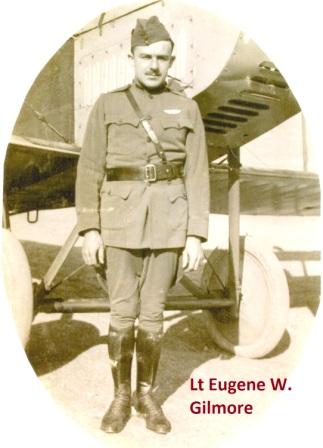LT Eugene Gilmore was born in 1896 and served with the “Foggiani” flying bombers in Italy during the First World War.
More about Gilmore from the Smithsonian Air Museum Hall of Fame:
Lt. Eugene W. Gilmore (1896-1971) was a junior at Syracuse University, NY, when the United States entered the First World War. He volunteered to serve his country. After basic training in rural Long Island's Camp Upton, near Yaphank, he became part of a contingent of some 500 Americans who, because of the lack of suitable training facilities in the United States, were sent to Foggia, Italy, to be taught military flying.
After completing their training, the new pilots were commissioned in the Army Air Service and the majority of them were sent to France to serve with the American Expeditionary Force. However, about 75 remained in Italy under the command of Captain Fiorello La Guardia, who simultaneously held office as a Congressman from New York, and later served as Mayor of New York City. These "Foggiani" were attached to Italian bomber squadrons, mostly at the San Pelaggio Air Base near Padua, to gain experience in bombardment and augment the understrength squadrons.
These missions marked the first combat bomber operations by members of the U. S. Army Air Service and were flown in Caproni bombers. American participation was very active and several airmen received Italy's highest decoration, the Medaglia di Oro, for their combat heroism. (In later years "Gramps" Gilmore would regale his descendants with stories of flying against Austrian Zeppelins and shooting at them with his pistol.)
Later in 1918, Lt. Gilmore was transferred to northern France to participate in aircraft testing. From the unit of 24 men with whom he served, only 6 returned home. The motors in some of the planes they were asked to test had never been turned on.
When the Armistice ended the war he returned from France to his native New York City in 1919, and married his sweetheart Mary Ellen Clarkin in 1920. They had 6 children; two of their 3 sons served in World War II and the youngest in the Korean War. For most of the next 51 years, he was a resident of Bay Ridge in Brooklyn. He was for many years an active member of the American Legion Aviators Post in New York.

PRIVATE CITIZENS SUPPORTING AMERICA'S HERITAGE
American
War Memorials Overseas, Inc.
War Memorials Overseas, Inc.
Gilmore Eugene
Name:
Eugene Gilmore
Rank:
Lieutenant
Serial Number:
Unit:
Foggiani
Date of Death:
0000-00-00
State:
New York
Cemetery:
Plot:
Row:
Grave:
Decoration:
Comments:
